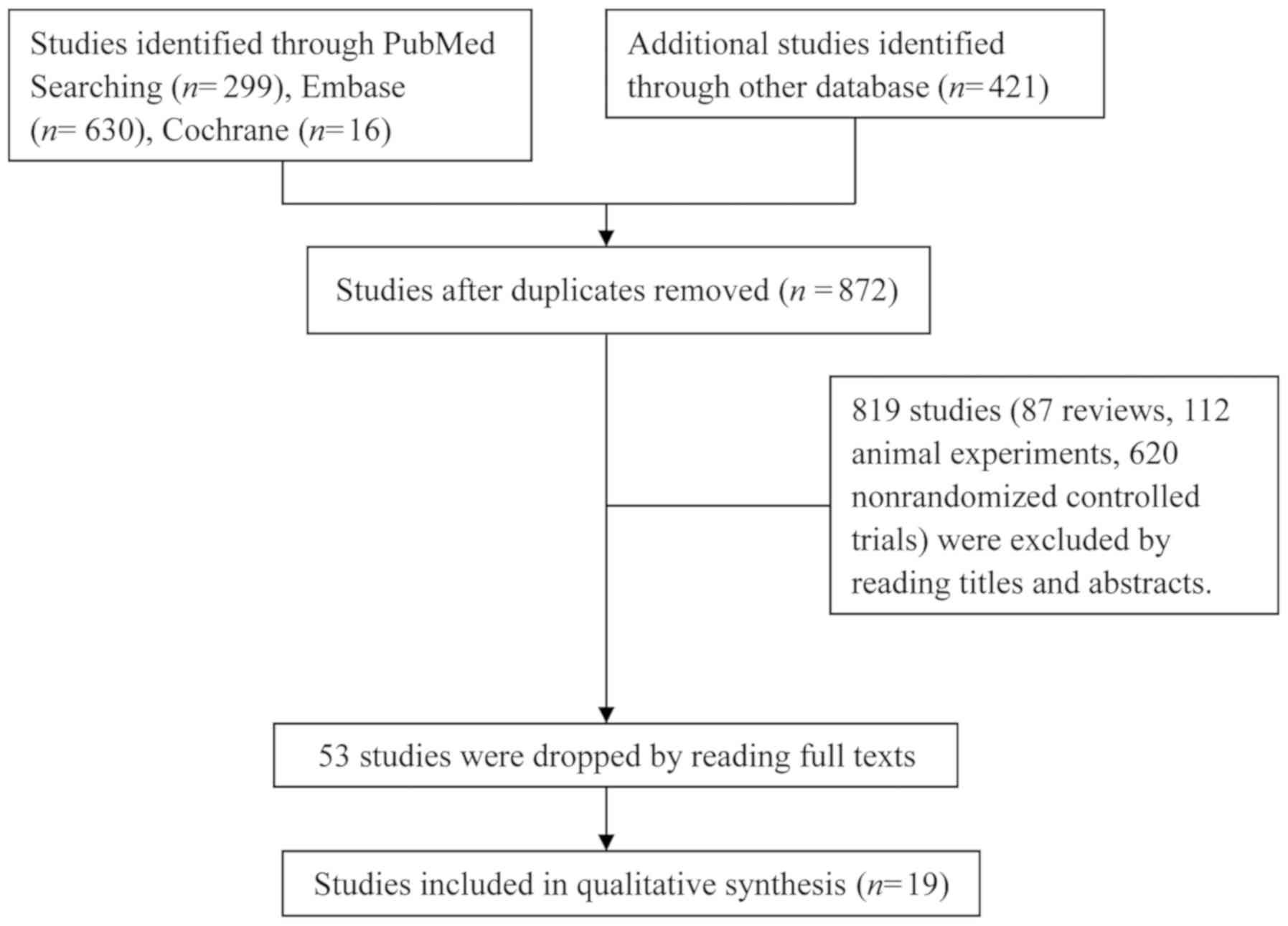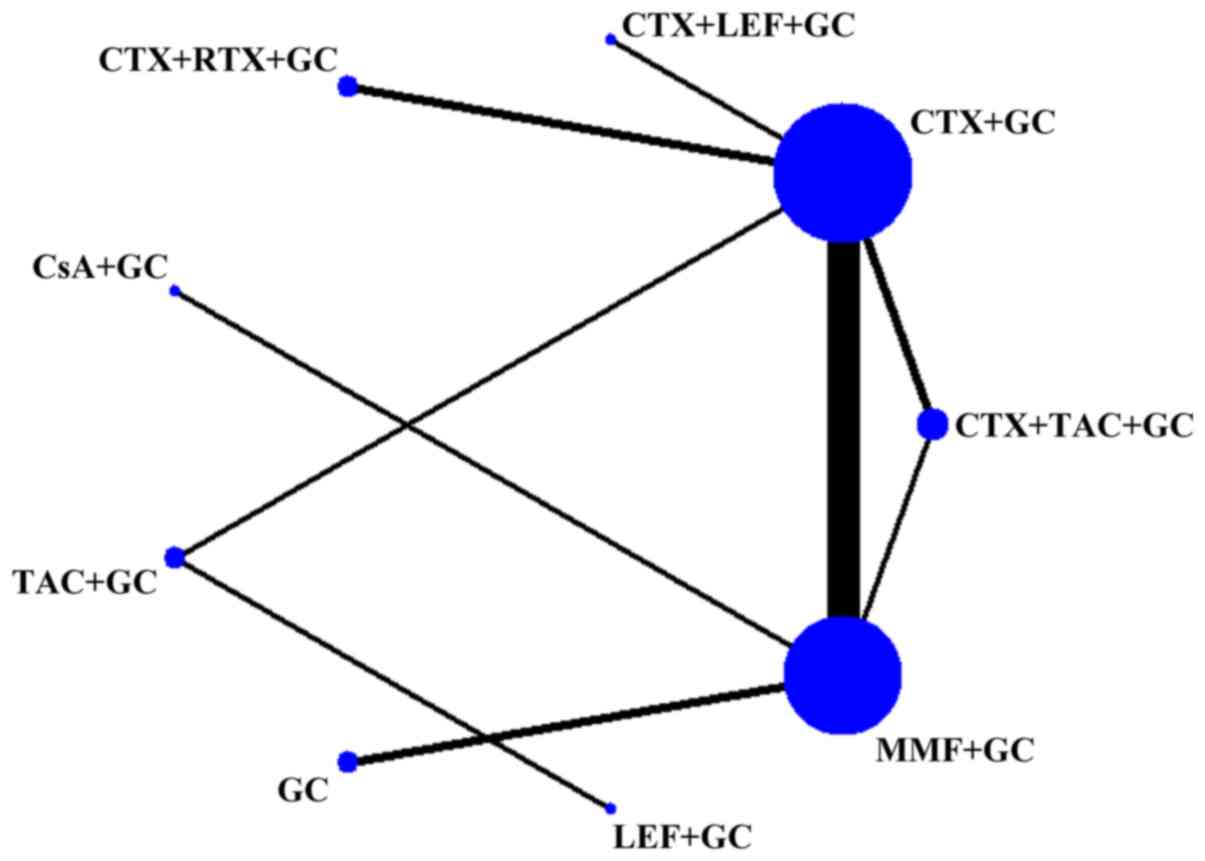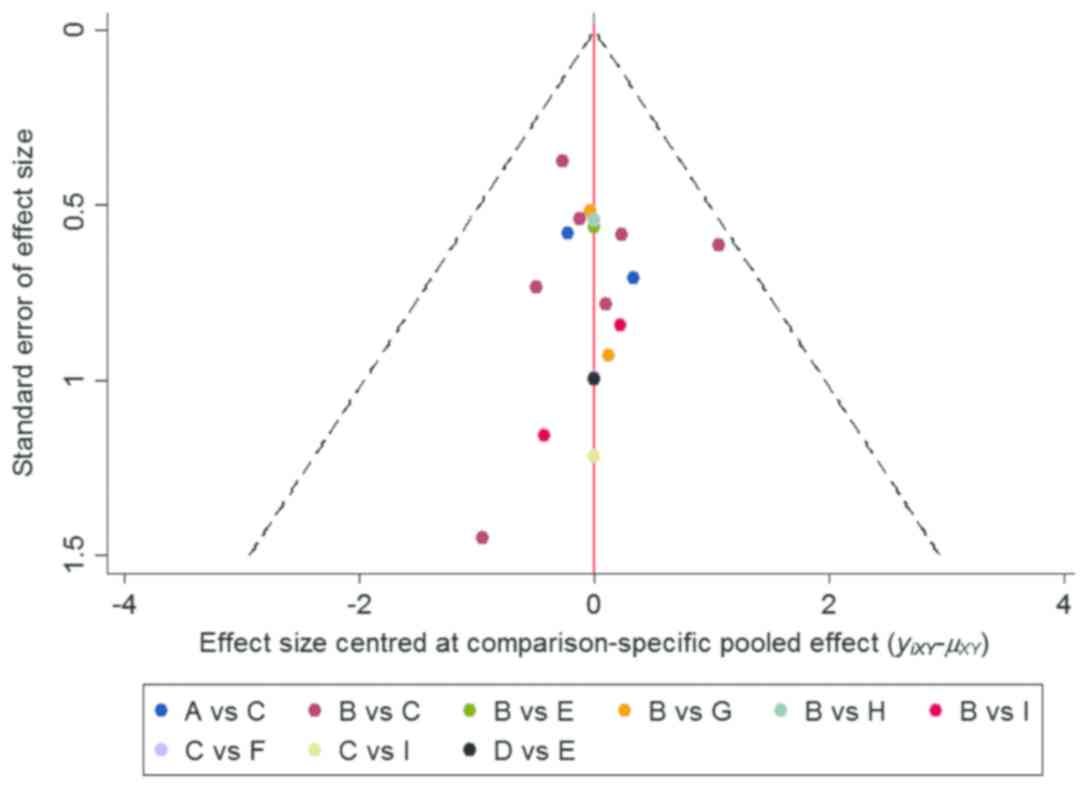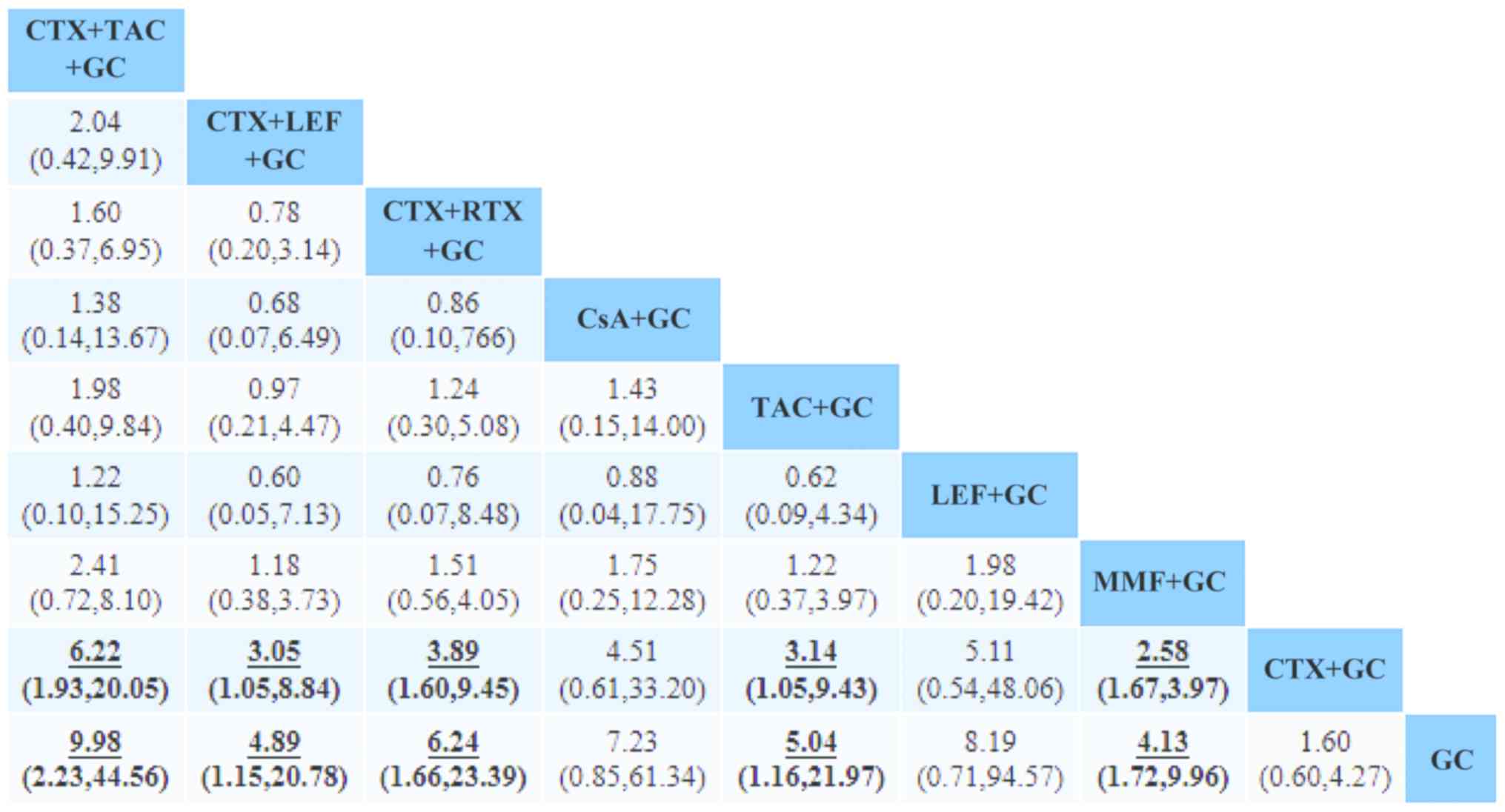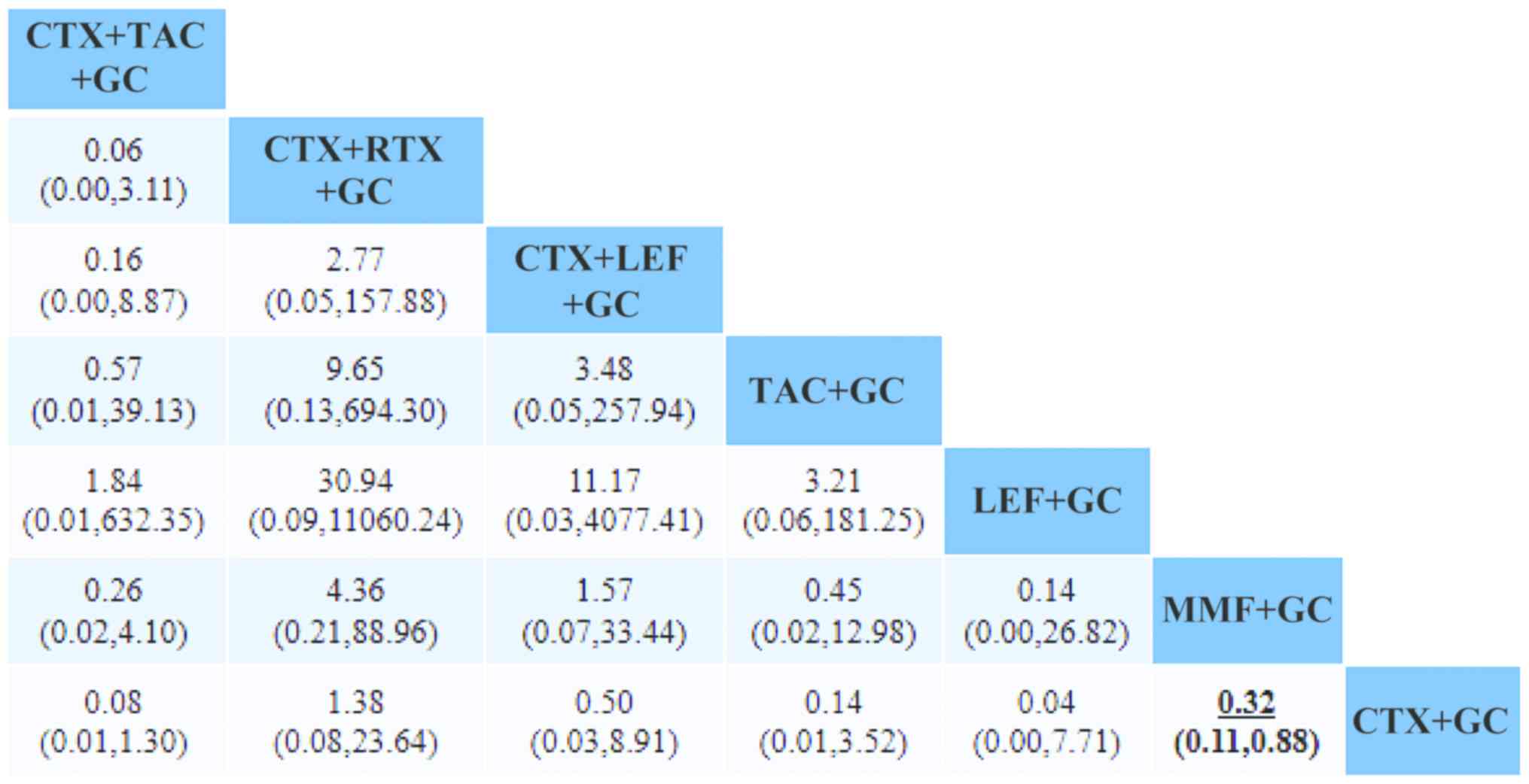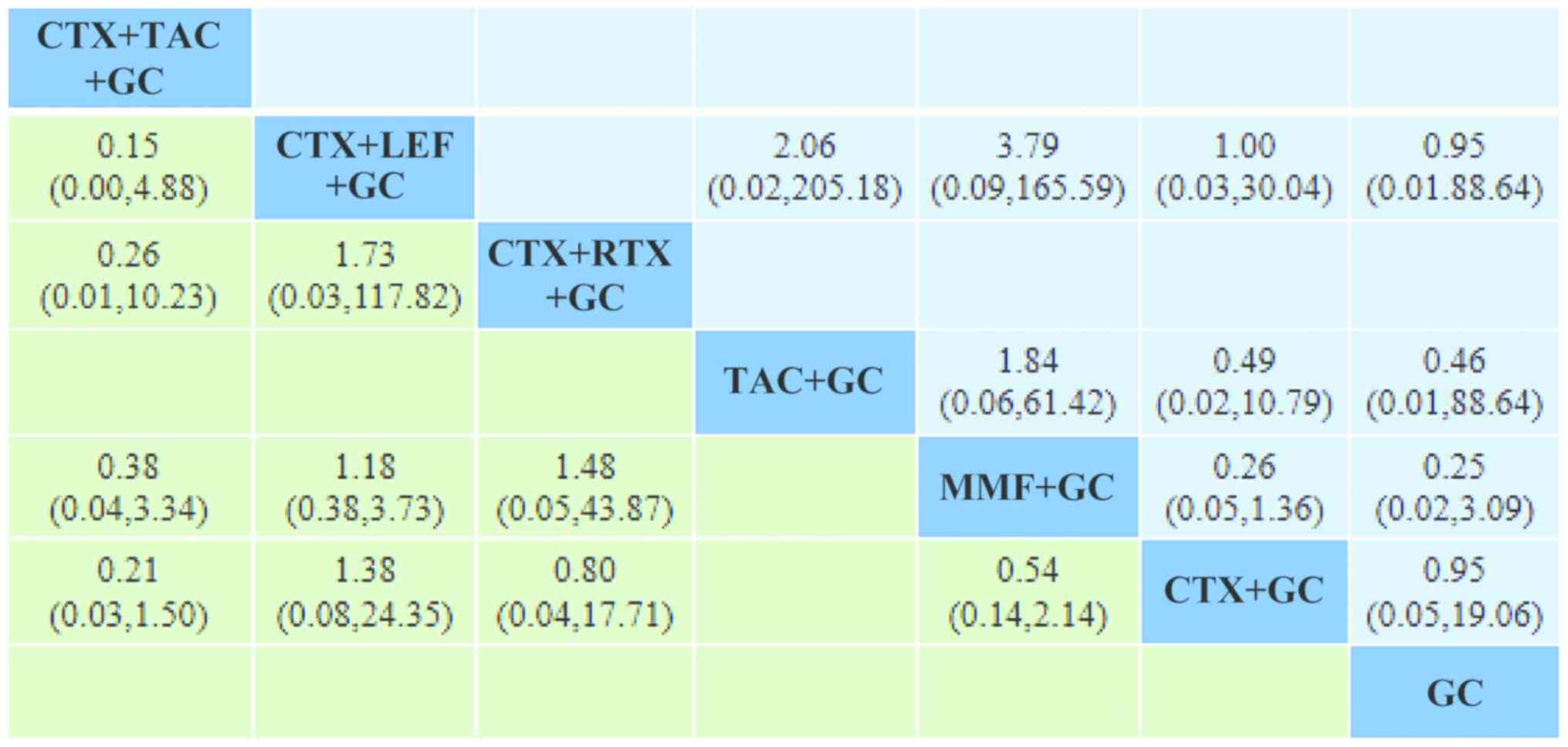|
1
|
Maroz N and Segal MS: Lupus nephritis and
end-stage kidney disease. Am J Med Sci. 346:319–323. 2013.
View Article : Google Scholar : PubMed/NCBI
|
|
2
|
Contis A, Vanquaethem H, Truchetet ME,
Couzi L, Rigothier C, Richez C, Lazaro E and Duffau P: Analysis of
the effectiveness and safety of rituximab in patients with
refractory lupus nephritis: A chart review. Clin Rheumatol.
35:517–522. 2016. View Article : Google Scholar : PubMed/NCBI
|
|
3
|
Moroni G and Ponticelli C: The
multifaceted aspects of refractory lupus nephritis. Expert Rev Clin
Immunol. 11:281–288. 2015. View Article : Google Scholar : PubMed/NCBI
|
|
4
|
Kronbichler A, Brezina B, Gauckler P,
Quintana LF and Jayne DRW: Refractory lupus nephritis: When, why
and how to treat. Autoimmun Rev. 18:510–518. 2019. View Article : Google Scholar : PubMed/NCBI
|
|
5
|
Momtaz M, Fayed A, Wadie M, Gamal SM,
Ghoniem SA, Sobhy N, Kamal Elden NM and Hamza WM: Retrospective
analysis of nephritis response and renal outcome in a cohort of 928
Egyptian lupus nephritis patients: A university hospital
experience. Lupus. 26:1564–1570. 2017. View Article : Google Scholar : PubMed/NCBI
|
|
6
|
Tang Y, Qin W, Peng W and Tao Y:
Development and validation of a prediction score system in lupus
nephritis. Medicine (Baltimore). 96:e80242017. View Article : Google Scholar : PubMed/NCBI
|
|
7
|
The CL, Phui VE, Ling GR, Ngu LS, Wan SA
and Tan CH: Causes and predictors of mortality in biopsy-proven
lupus nephritis: The Sarawak experience. Clin Kidney J. 11:56–61.
2018. View Article : Google Scholar : PubMed/NCBI
|
|
8
|
Pons-Estel GJ, Serrano R, Plasín MA,
Espinosa G and Cervera R: Epidemiology and management of refractory
lupus nephritis. Autoimmun Rev. 10:655–663. 2011. View Article : Google Scholar : PubMed/NCBI
|
|
9
|
Xiang H: Clinical efficacy of leflunomide
and cyclophosphamide in the treatment of patients with severe
refractory lupus nephritis. Hebei Med J. 39:919–920. 2017.(In
Chinese).
|
|
10
|
Jadad AR, Moore RA, Carroll D, Jenkinson
C, Reynolds DJ, Gavaghan DJ and McQuay HJ: Assessing the quality of
reports of randomized clinical trials: Is blinding necessary?
Control Clin Trials. 17:1–12. 1996. View Article : Google Scholar : PubMed/NCBI
|
|
11
|
Zhang C, Yan JZ, Sun F, Liu Q, Guo Y and
Zeng XT: Differentiation and handling of homogeneity in network
meta-analysis. Chin J Evidence Based Med. 14:884–888. 2014.
|
|
12
|
Ma Y, Song Y, Tong SS, Wang X, Wang GZ and
Dai H: Analysis of the therapeutic effect of mycophenolate mofetil
on refractory lupus nephritis. World Latest Med Information.
16:832016.(In Chinese).
|
|
13
|
Li L: Analysis of the efficacy of
mycophenolate mofetil in the treatment of refractory lupus
nephritis and its effect on clinical symptoms. China Med Herald.
9:75–76. 2012.(In Chinese).
|
|
14
|
Wang Z, Zheng DW and Liu GH: The curative
effect and safety of refractory lupus nephristis treated by
mycophenolate mofetil combined with prednisone. J North Pharm.
12:127–128. 2015.(In Chinese).
|
|
15
|
Zheng S, Zheng JG, Han L and Wang DH: 31
cases of clinical curative effect analysis of mycophenolate mofetil
treat refractory lupus nephritis. World Latest Med Information.
15:20–67. 2015.(In Chinese).
|
|
16
|
Dong YM, Zhou LZ, Li J, Li QH and Liu Z:
Therapeutic effect of mycophenolate mofetil combined with
prednisone in the treatment of refractory lupus nephritis. Chin J
Clin Rational Drug Use. 7:44–45. 2014.(In Chinese).
|
|
17
|
Liu CY, Jiang Y and Wang L: Comparison of
curative effect of mycophenolate mofetil and cyclophosphamide for
the treatment of refractory lupus nephritis. China Modern Doctor.
51:48–50. 2013.(In Chinese).
|
|
18
|
Liu CY: Application of mycophenolate
mofetil and cyclophosphamide in refractory lupus nephritis. Strait
Pharmaceutical J. 21:137–138. 2009.(In Chinese).
|
|
19
|
Yang FF, Lin B, Wang J and You YW:
Efficacy evaluation of combined immunosuppressive agents in the
treatment of refractory lupus nephritis. Chin Youjiang Med J.
36:134–135. 2008.(In Chinese).
|
|
20
|
Zhen HM, Zhang HY, Huo G, Zhao SJ and Li
JS: Clinical observation of steroid combined with mycophenolate
mofetil in the treatment of refractory lupus nephritis. Inner
Mongolia Med J. 38:1023–1025. 2006.(In Chinese).
|
|
21
|
Shi J, Chen BP and He XZ: Clinical
efficacy of mycophenolate mofetil in the treatment of 26 cases of
refractory type IV lupus nephritis. Negative. 27:19202006.(In
Chinese).
|
|
22
|
Li L, Li WQ and Qi WC: Clinical
observation of mycophenolate mofetil in the treatment of refractory
lupus nephritis. Chin J Postgraduates Med. 25:42–43. 2002.(In
Chinese).
|
|
23
|
Lu Y: One-year follow-up observation of
tacrolimus in the treatment of refractory lupus nephritis. J Med
Forum. 38:167–169. 2017.(In Chinese).
|
|
24
|
Liu H, Huang DQ and Liang Y: Comparative
study of tacrolimus and leflunomide in the treatment of refractory
lupus nephritis. J Qiqihar Med University. 37:3419–3420. 2016.(In
Chinese).
|
|
25
|
Liang B, Zhang JH, Wang CA and Han JL:
Comparison of traditional treatment and multi-target treatment for
refractory lupus nephritis. Chin J Control Endemic Diseases.
29:34–35. 2014.(In Chinese).
|
|
26
|
YI L, Luo FZ, Deng CP and Wu CY:
Application of rituximab monoclonal antibody in the treatment of
refractory lupus nephritis. J Nanjing Med University (Natural
Sciences). 34:1102–1104. 2014.(In Chinese).
|
|
27
|
Mostafi M, Rabbani MG, Hossain MR,
Siddiqui AR and Rabbani SB: Cyclosporine & mycophenolate
mofetil in the treatment of cyclophosphamide refractory Class-IV
lupus nephritis. JAFMC Bangladesh. 5:8–13. 2009.
|
|
28
|
Zhang J, Zhao Z and Hu X: Effect of
rituximab on serum levels of anti-C1q and antineutrophil
cytoplasmic autoantibodies in refractory severe lupus nephritis.
Cell Biochem Biophys. 72:197–201. 2015. View Article : Google Scholar : PubMed/NCBI
|
|
29
|
Mo YM and Li Long: Comparison of multiple
target regimens and traditional classic regimens in the treatment
of refractory lupus nephritis. Clin Misdiagnosis Mistherapy.
22:53–54. 2009.(In Chinese).
|
|
30
|
Kasitanon N, Boripatkosol P and Louthrenoo
W: Response to combination of mycophenolate mofetil, cyclosporin A
and corticosteroid treatment in lupus nephritis patients with
persistent proteinuria. Int J Rheum Dis. 21:200–207. 2018.
View Article : Google Scholar : PubMed/NCBI
|
|
31
|
Sedhain A, Hada R, Agrawal RK, Bhattarai
GR and Baral A: Low dose mycophenolate mofetil versus
cyclophosphamide in the induction therapy of lupus nephritis in
Nepalese population: A randomized control trial. BMC Nephrol.
19:1752018. View Article : Google Scholar : PubMed/NCBI
|
|
32
|
Joo YB, Kang YM, Kim HA, Suh CH, Kim TJ,
Park YW, Lee J, Lee JH, Yoo DH, Bae SC, et al: Outcome and
predictors of renal survival in patients with lupus nephritis:
Comparison between cyclophosphamide and mycophenolate mofetil. Int
J Rheum Dis. 21:1031–1039. 2018. View Article : Google Scholar : PubMed/NCBI
|
|
33
|
Hannah J, Casian A and D'Cruz D:
Tacrolimus use in lupus nephritis: A systematic review and
meta-analysis. Autoimmun Rev. 15:93–101. 2016. View Article : Google Scholar : PubMed/NCBI
|
|
34
|
Mok CC: Calcineurin inhibitors in systemic
lupus erythematosus. Best Pract Res Clin Rheumatol. 31:429–438.
2017. View Article : Google Scholar : PubMed/NCBI
|
|
35
|
Bao H, Liu ZH, Xie HL, Hu WX, Zhang HT and
Li LS: Successful treatment of class V+IV lupus nephritis with
multitarget therapy. J Am Soc Nephrol. 19:2001–2010. 2008.
View Article : Google Scholar : PubMed/NCBI
|
|
36
|
Jesus D, Rodrigues M, da Silva JAP and
Inês L: Multitarget therapy of mycophenolate mofetil and
cyclosporine A for induction treatment of refractory lupus
nephritis. Lupus. 27:1358–1362. 2018. View Article : Google Scholar : PubMed/NCBI
|
|
37
|
Choi CB, Won S and Bae SC: Outcomes of
multitarget therapy using mycophenolate mofetil and tacrolimus for
refractory or relapsing lupus nephritis. Lupus. 27:1007–1011. 2018.
View Article : Google Scholar : PubMed/NCBI
|
|
38
|
Xiao CJ, Rao H, Xu XY and Zeng QH:
Clinical analysis of 23 cases of V+IV lupus nephritis treated with
multiple targets. Chin J Clin (Electronic Edition). 7:6733–6734.
2013.
|
|
39
|
Morales E, Valero MA, León M, Hernández E
and Praga M: Beneficial effects of weight loss in overweight
patients with chronic proteinuric nephropaties. Am J Kidney Dis.
41:319–327. 2003. View Article : Google Scholar : PubMed/NCBI
|
|
40
|
Szulińska M, Skrypnik D, Ratajczak M,
Karolkiewicz J, Madry E, Musialik K, Walkowiak J, Jakubowski H and
Bogdański P: Effects of endurance and endurance-strength exercise
on renal function in abdominally obese women with renal
hyperfiltration: A prospective randomized trial. Biomed Environ
Sci. 29:706–771. 2016.PubMed/NCBI
|















